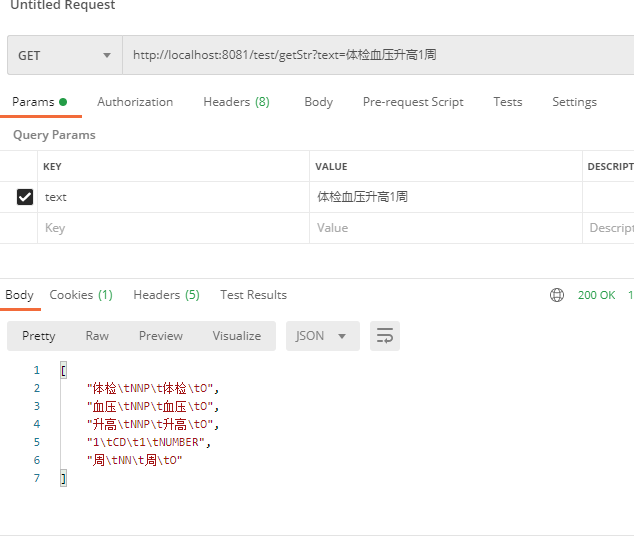java自然语言StanfordCoreNLP入门
java对自然语言的处理。上手实践,跑的通是关键。只需三步即可。代码地址:https://gitee.com/huqianming/java-nlp.git 注意:中文模型包有点大,maven可以配置从阿里私服仓库读取。第一次请求要初始化稍微慢一下
1、所需依赖的包,这里用到中文的包
1 2 3 4 5 6 7 8 9 10 11 12 13 14 15 16 17 18 19 | <dependency> <groupId>edu.stanford.nlp</groupId> <artifactId>stanford-corenlp</artifactId> <version>4.2.0</version></dependency><dependency> <groupId>edu.stanford.nlp</groupId> <artifactId>stanford-corenlp</artifactId> <version>4.2.0</version> <classifier>models</classifier></dependency><dependency> <groupId>edu.stanford.nlp</groupId> <artifactId>stanford-corenlp</artifactId> <version>4.2.0</version> <classifier>models-chinese</classifier></dependency> |
2、创建好Spring boot项目,创建类使用如下代码
package com.nunu.ai.nlp.controller; import edu.stanford.nlp.coref.CorefCoreAnnotations; import edu.stanford.nlp.coref.data.CorefChain; import edu.stanford.nlp.ling.CoreAnnotations; import edu.stanford.nlp.ling.CoreLabel; import edu.stanford.nlp.pipeline.Annotation; import edu.stanford.nlp.pipeline.StanfordCoreNLP; import edu.stanford.nlp.semgraph.SemanticGraph; import edu.stanford.nlp.semgraph.SemanticGraphCoreAnnotations; import edu.stanford.nlp.trees.Tree; import edu.stanford.nlp.trees.TreeCoreAnnotations; import edu.stanford.nlp.util.CoreMap; import edu.stanford.nlp.util.PropertiesUtils; import edu.stanford.nlp.util.StringUtils; import org.springframework.web.bind.annotation.RequestMapping; import org.springframework.web.bind.annotation.RestController; import java.util.ArrayList; import java.util.List; import java.util.Map; import java.util.Properties; /** * created with IDEA * * @author:huqm * @date:2020/12/7 * @time:16:20 <p> * * </p> */ @RestController @RequestMapping("/test") public class TestController { @RequestMapping("getStr") public List<String> getStr(String text){ return segInCh(text); } public List<String> segInCh(String text) { //载入properties 文件 // StanfordCoreNLP pipline = new StanfordCoreNLP("StanfordCoreNLP-chinese.properties"); //1.2 自定义功能 (1) //StanfordCoreNLP的各个组件(annotator)按“tokenize(分词), ssplit(断句), pos(词性标注), lemma(词元化), // ner(命名实体识别), parse(语法分析), dcoref(同义词分辨)”顺序进行处理。 // Properties properties = new Properties(); // properties.setProperty("annotators", "tokenize, ssplit, pos, lemma, ner, parse, dcoref"); // StanfordCoreNLP pipline = new StanfordCoreNLP(properties); //自定义功能(2) 自己在项目中建一个properties 文件,然后在文件中设置模型属性,可以参考1中的配置文件 // String[] args = new String[]{"-props", "properies/CoreNLP-Seg-CH.properties"}; // Properties properties = StringUtils.argsToProperties(args); // StanfordCoreNLP pipline = new StanfordCoreNLP(properties); //自定义功能(3) StanfordCoreNLP pipline = new StanfordCoreNLP(PropertiesUtils.asProperties( "annotators", "tokenize,ssplit,pos,lemma,ner,parse,dcoref", "ssplit.isOneSentence", "true", "tokenize.language", "zh", "segment.model", "edu/stanford/nlp/models/segmenter/chinese/ctb.gz", "segment.sighanCorporaDict", "edu/stanford/nlp/models/segmenter/chinese", "segment.serDictionary", "edu/stanford/nlp/models/segmenter/chinese/dict-chris6.ser.gz", "segment.sighanPostProcessing", "true" )); //创建一个解析器,传入的是需要解析的文本 Annotation annotation = new Annotation(text); //解析 pipline.annotate(annotation); //根据标点符号,进行句子的切分,每一个句子被转化为一个CoreMap的数据结构,保存了句子的信息() List<CoreMap> sentences = annotation.get(CoreAnnotations.SentencesAnnotation.class); //从CoreMap 中取出CoreLabel List ,打印 ArrayList<String> list = new ArrayList<>(); for (CoreMap sentence : sentences) { for (CoreLabel token : sentence.get(CoreAnnotations.TokensAnnotation.class)) { String word = token.get(CoreAnnotations.TextAnnotation.class); // this is the POS tag of the token String pos = token.get(CoreAnnotations.PartOfSpeechAnnotation.class); // this is the NER label of the token String ne = token.get(CoreAnnotations.NamedEntityTagAnnotation.class); String lemma = token.get(CoreAnnotations.LemmaAnnotation.class); String result=word+"\t"+pos+"\t"+lemma+"\t"+ne; list.add(result); } } return list; } }
3、验证结果

雪人正在努力……
posted on 2020-12-07 20:57 Snowman-Nunu 阅读(3003) 评论(0) 编辑 收藏 举报




【推荐】编程新体验,更懂你的AI,立即体验豆包MarsCode编程助手
【推荐】凌霞软件回馈社区,博客园 & 1Panel & Halo 联合会员上线
【推荐】抖音旗下AI助手豆包,你的智能百科全书,全免费不限次数
【推荐】博客园社区专享云产品让利特惠,阿里云新客6.5折上折
【推荐】轻量又高性能的 SSH 工具 IShell:AI 加持,快人一步